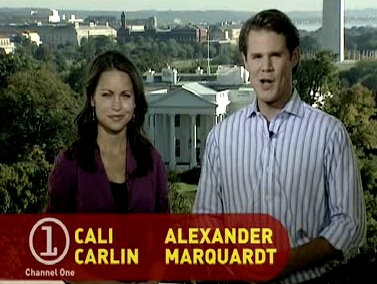
Deconstructing Channel One News:
The anchor welcomes students to the day’s broadcast. (Notice the window behind him.)
The Channel One News show is constructed in a way to make students think that it is live when in fact it is 100% taped. Parts of it are taped the day before and parts are taped days, weeks and sometimes years before. (Channel One often replays stories that were produced and aired years ago. This helps to lower current production costs. They don’t have to pay people to produce new, timely content when they can recycle older stories.)
There is no graphic on the screen that says "taped yesterday" or "previously recorded." The scripts are written to make students believe the anchors are currently reporting the news. They do sometimes acknowledge their deadline which means the show is taped, but they don’t draw attention to the fact that the show is at least a 1/2-day old by the time most students watch it.
Students seeing Mr. Marquardt above would think that Channel One News has a very nice studio that overlooks the Capitol. This view says that Channel One News is an important news-gathering organization in Washington DC. Nothing could be further from the truth.
Mr. Marquardt is sitting in front of a picture of the Washington skyline. The window frame was added by studio carpenters to make it look real. It is all fake. Other news shows do something like this but it is usually very obvious it is a picture. Channel One doesn’t want students to know this is a picture. It’s part of their illusion.
I have been to Channel One’s new DC studio. It is nowhere near the Capitol. There studio is in a strip shopping center up Connecticut Avenue. The view out the back is not of the Capitol but of houses, parked cars and trash containers.
Look at this frame from the October 10 Channel One show:

This isn’t fake. The two C1N reporters are indeed across from the White House. They are introducing a story about North Korea exploding a nuclear bomb.
This is what these reporters said as they were on the screen:
CALI: AND I’M CALI CARLIN, HOPE YOU’RE HAVING A GREAT DAY. WE’RE HERE IN FRONT OF THE WHITE HOUSE WHERE THE CONVERSATION CENTERED AROUND OUR TOP STORY.
ALEXANDER: AND THAT STORY IS THE CLAIM BY NORTH KOREA THAT THEY HAVE CONDUCTED A NUCLEAR TEST. HERE’S A LOOK AT WHAT WE KNOW SO FAR.
A media literate student would ask, "Why do they have the White House in the background? Why aren’t they reporting this story from their studio?"
If the White House has ANYTHING to do with a story, that’s enough for Channel One. The White House will be in the background, even if it sends the wrong message to students. For example, the reaction of the president was not the main part of the Korea/nuke story that day. It was the U.N. and China, but Channel One wasn’t about to pay for a reporter to be filmed in front of the U.N. in New York City.
Channel One producers obviously want to use the image of the White House to lend the newscast some importance. The White House is important therefore whatever these two say in front of it will be important.
Everyone has seen similar camera stunts on their local newscasts. A reporter is shown "Live" in front of a courthouse on the 10 o’clock news show. Why is she or he there? It is dark. Everybody else has gone home hours ago. There is no news happening at this location at the moment, but the station wants the audience to see the "Live" graphic and know that the station is always "on the scene" even when it doesn’t make any sense.
By moving to Washington, Channel One has many background scenes that can be used to make their stories look more relevant and timely.
By being in front of the White House, the reporters are "on location." That shows they are tireless and will travel the world to "get the story." Actually this location is just two miles from their studio (Van Ness Square Shopping Center) .
This is all about image. Channel One relies on film footage from the Associated Press and ABC News. They have to add some value themselves and the easiest thing to do is to have an introductory shot in front of a recognizable landmark.
Students should keep track of how many Channel One stories begin with an exterior shot in Washington DC and surrounding areas. If there is breaking news in Mexico, will Channel One send a reporter to Mexico and submit a report from that country or will they merely film themselves in front of the Mexican embassy and read something off the AP wire? Any story about education and they can position their cameras in front of the Department of Education.

